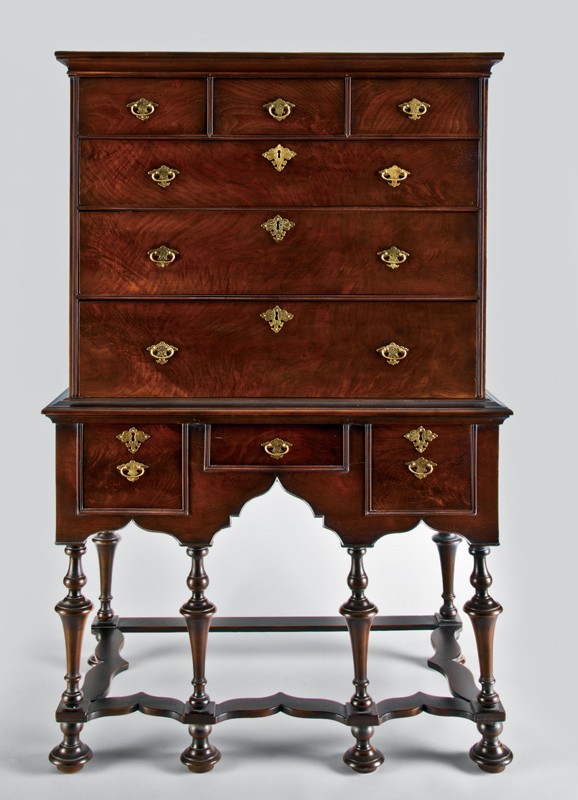
High chest by John Head, Philadelphia, Pennsylvania, 1726. Walnut with white cedar and yellow pine. H. 66 7/8", W. 42 1/8", D. 23 1/4". (Courtesy, Philadelphia Museum of Art, gift of Lydia Thompson Morris; photo, Gavin Ashworth.)
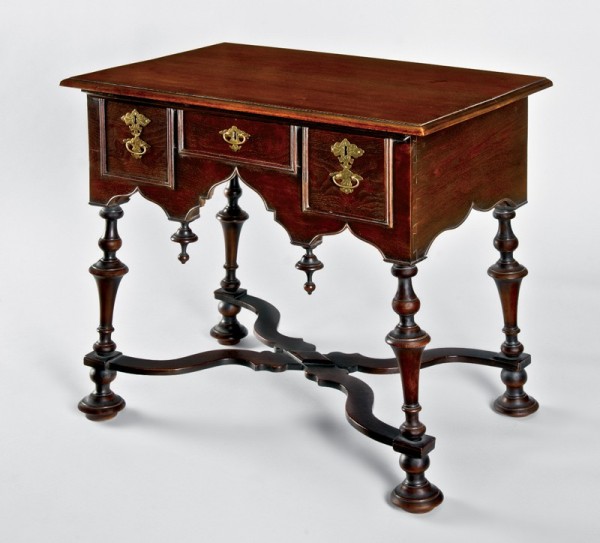
Dressing table by John Head, Philadelphia, Pennsylvania, 1726. Walnut with white cedar and yellow pine. H. 29", W. 33 5/8", D. 21 1/2". (Courtesy, Philadelphia Museum of Art, gift of Lydia Thompson Morris; photo, Gavin Ashworth.)
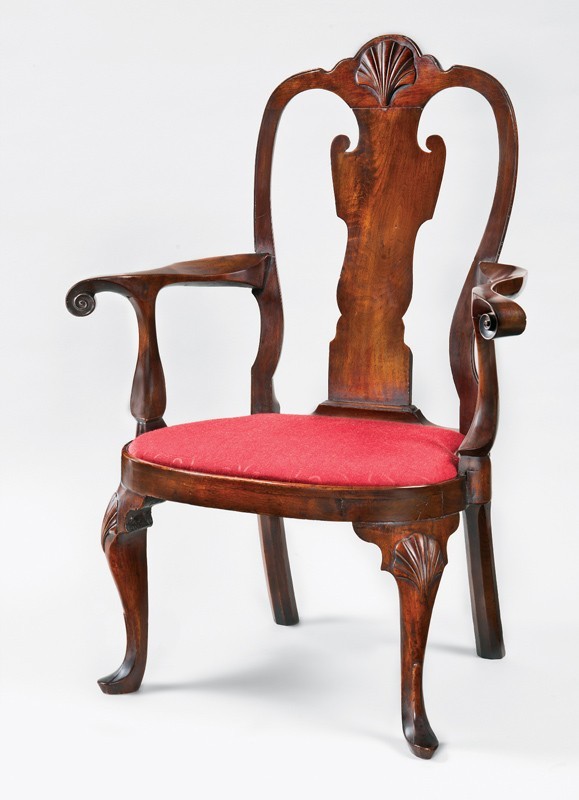
Armchair, Philadelphia, Pennsylvania, 1735–1745. Walnut with yellow pine. H. 42 1/4", W. 32 3/8" (seat), D. 20 3/4" (seat). (Chipstone Foundation; photo, Gavin Ashworth.) This armchair was part of a suite that included several side chairs and probably a matching armchair. Several of the side chairs are at Wyck, the Germantown home of Caspar Wistar. During the battle of Germantown, the British used Wyck as a field hospital, and the chaos of that episode is, by family legend, responsible for the rough condition of the side chairs. An armchair from the shop that produced Wistar’s suite is depicted in Thomas Hicks’s painting of a kitchen interior (fig. 68).

Peter Cooper, The Southeast Prospect of the City of Philadelphia, ca. 1720. Oil on canvas. 20" x 87". (Courtesy, The Library Company of Philadelphia.)
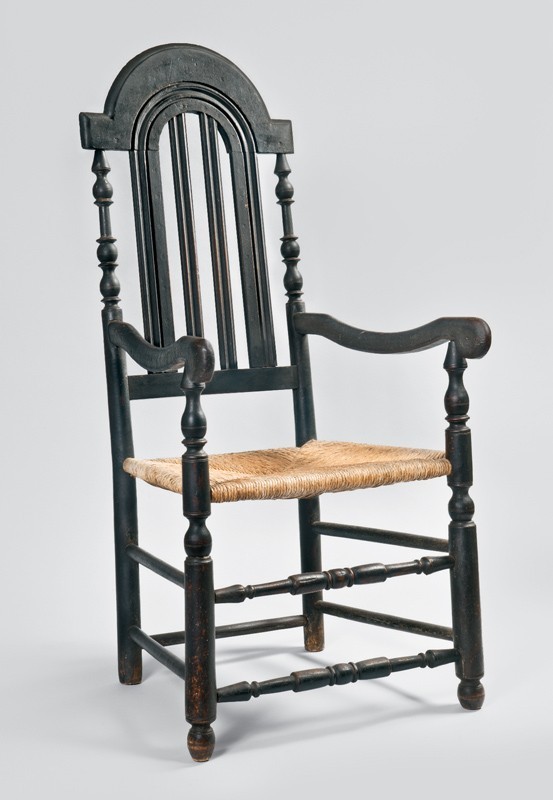
Armchair, Philadelphia vicinity,Pennsylvania, 1715–1730. Maple and ash. H. 48", W. 21 1/2", D. 18 1/4". (Private collection; photo, Gavin Ashworth.)
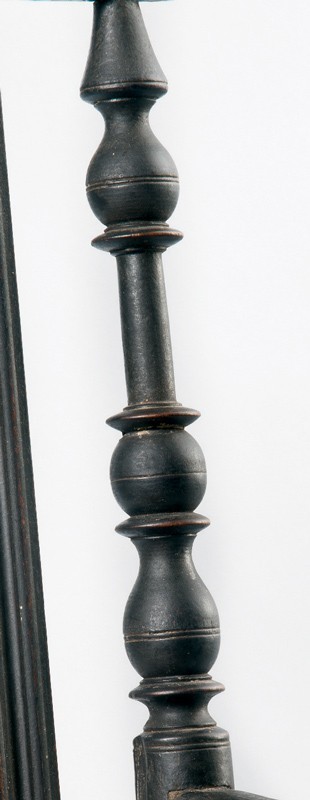
Detail of the right rear post of the armchair illustrated in fig. 5. (Photo, Gavin Ashworth.)
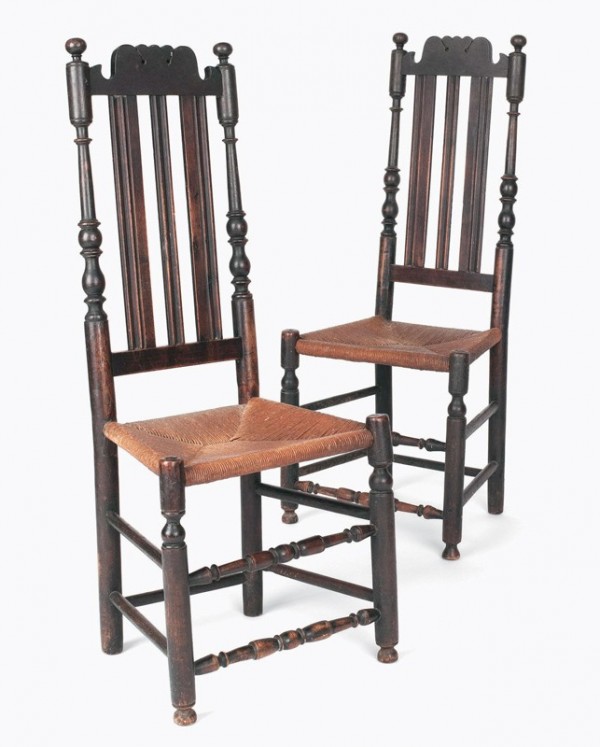
Pair of side chairs, Philadelphia vicinity, Pennsylvania, 1715–1730. Maple and ash. Dimensions not recorded. (Private collection; photo, Pook and Pook.)

Detail of the left front leg of the dressing table illustrated in fig. 2. (Photo, Gavin Ashworth.)

High chest attributed to John Head, Philadelphia, Pennsylvania, 1719–1732. Red cedar with white cedar and yellow pine. H. 70 7/8", W. 43 3/8", D. 23 5/8". (Private collection; photo, Gavin Ashworth.)
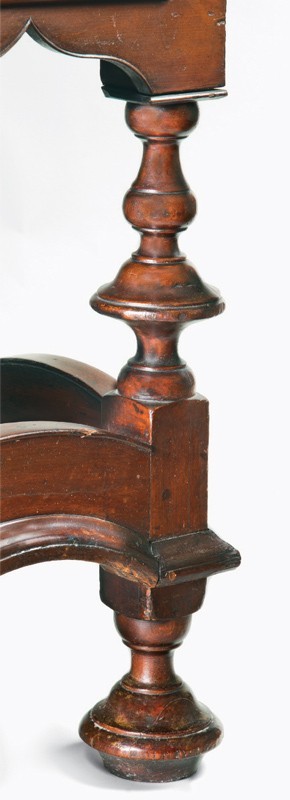
Detail of the right front leg of the high chest illustrated in fig. 9. (Photo, Gavin Ashworth.)
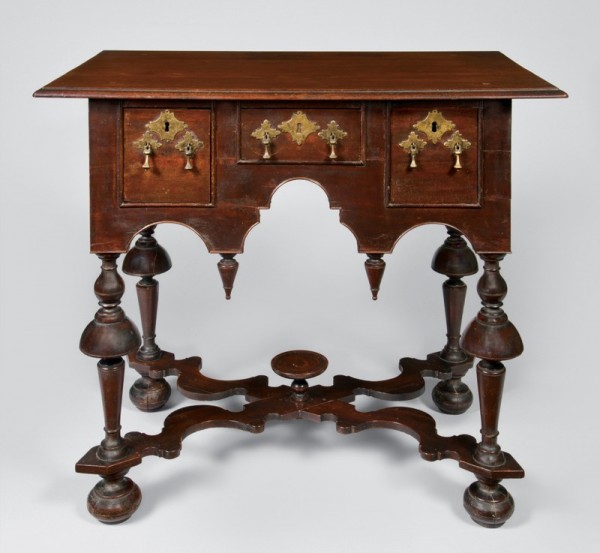
Dressing table, Philadelphia, Pennsylvania, ca. 1725. H. 30", W. 34", D. 20 1/2". (Chipstone Foundation; photo, Gavin Ashworth.) As on the Wistar dressing table (fig. 2), the turnings of the drops echo passages of the legs.

Detail of the left front leg of the dressing table illustrated in fig. 11. (Photo, Gavin Ashworth.)
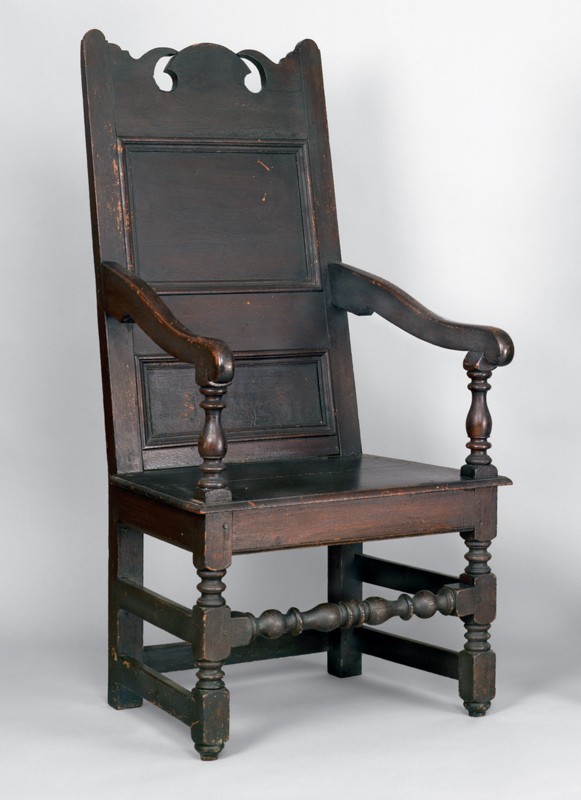
Armchair, Philadelphia or Chester County, Pennsylvania, 1720–1740. Walnut. H. 40 3/8", W. 19 3/4", D. 16". (Courtesy, Primative Hall Foundation; photo, Lazlo Bodo.)
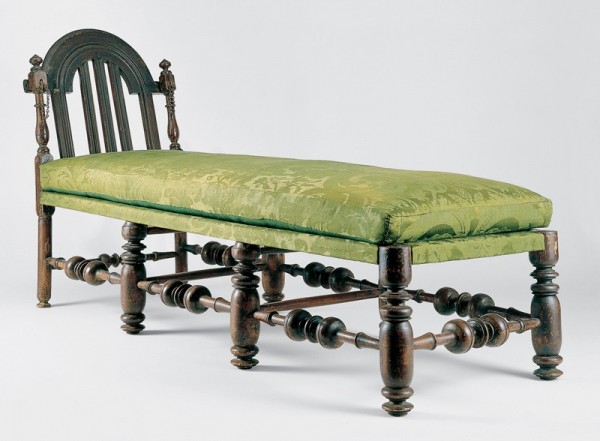
Couch, Philadelphia, Pennsylvania, 1715–1725. Maple with oak and unidentified secondary woods. H. 38 1/4", W. 24 1/2", L. 69". (Private collection; photo, Philadelphia Museum of Art.) The bannisters of the back are molded with a sash plane, a creative adaptation by the maker. These tools were among the earliest dedicated sole planes to be used in Philadelphia, as they were essential for making double-hung windows.

Couch, probably Philadelphia, Pennsylvania, 1725–1735. Maple. H. 37", W. 23 1/4", L. 69 1/4". (Courtesy, Wright’s Ferry Mansion.)
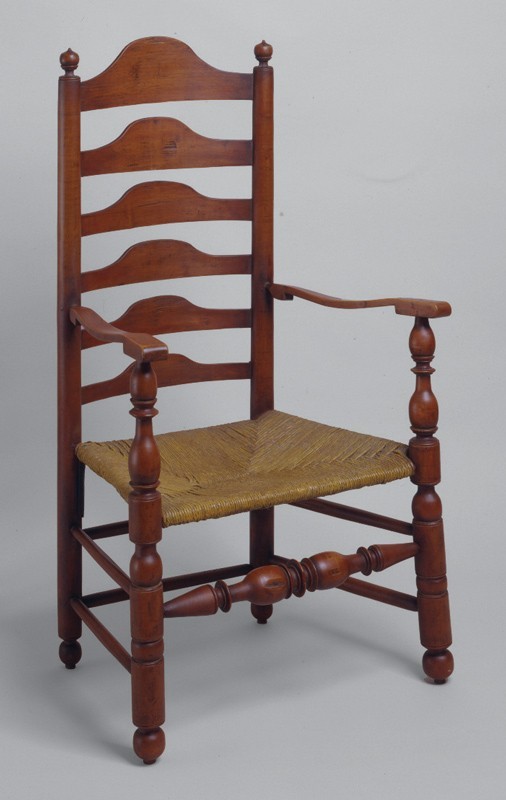
Armchair, Philadelphia, Pennsylvania, ca. 1730. Maple; remnants of original red paint. H. 48". (Courtesy, Philip Bradley Antiques.)

Windsor armchair, Philadelphia, Pennsylvania, 1745–1765. Maple and tulip poplar with unidentified hardwoods. H. 17", W. 27 1/2", D. 20". (Courtesy, Philip Bradley Antiques.) Philadelphia Windsor chairs, employing this turning, were successful trade items in coastal shipping and became the archetypal model for the Windsor chair, supplanting the British version.
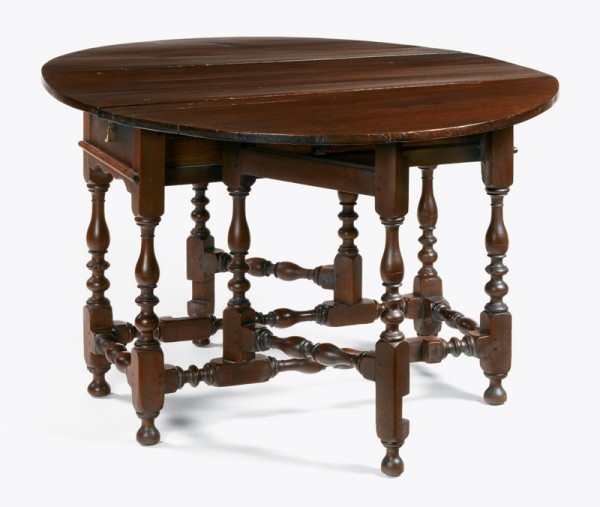
Gateleg table, Philadelphia, Pennsylvania, 1720–1725. Walnut with yellow pine. H. 28 1/4", top: 51 5/8" x 41 1/4" (open). (Private collection; photo, Gavin Ashworth.) Turnings similar to those on this table occur on sophisticated Philadelphia work as late as the 1730s and on simple urban and vernacular furniture, particularly Germanic objects, throughout the eighteenth century.
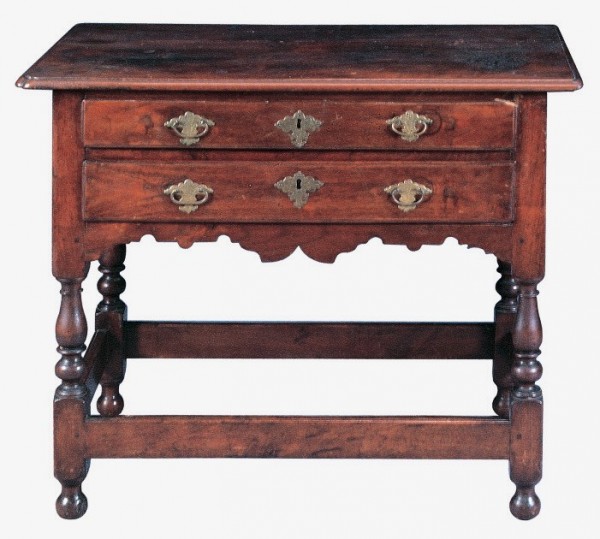
Dressing table, probably from the shop of Joseph, George, or Josiah Claypoole, 1725–1745. Walnut with white cedar and yellow pine. H. 29", W. 34 1/2", D. 20 1/4". (Private collection; photo, Christie’s.) The small astragal drops and arches of the front rail are typical of the Claypoole family’s work.
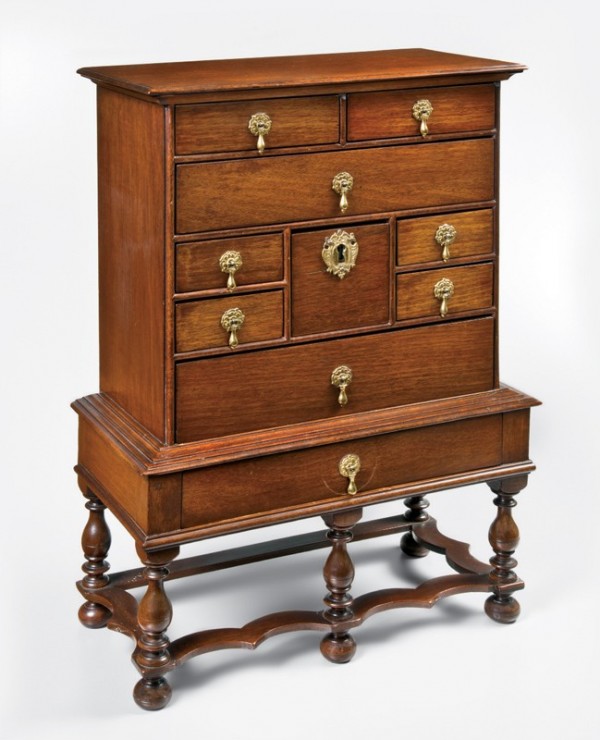
Chest-on-stand, possibly from the shop of Joseph Claypoole, Philadelphia, Pennsylvania, 1715–1725. Mahogany with white cedar and yellow pine. H. 25 1/2", W. 18 5/8", D. 9". (Chipstone Foundation; photo, Gavin Ashworth.)
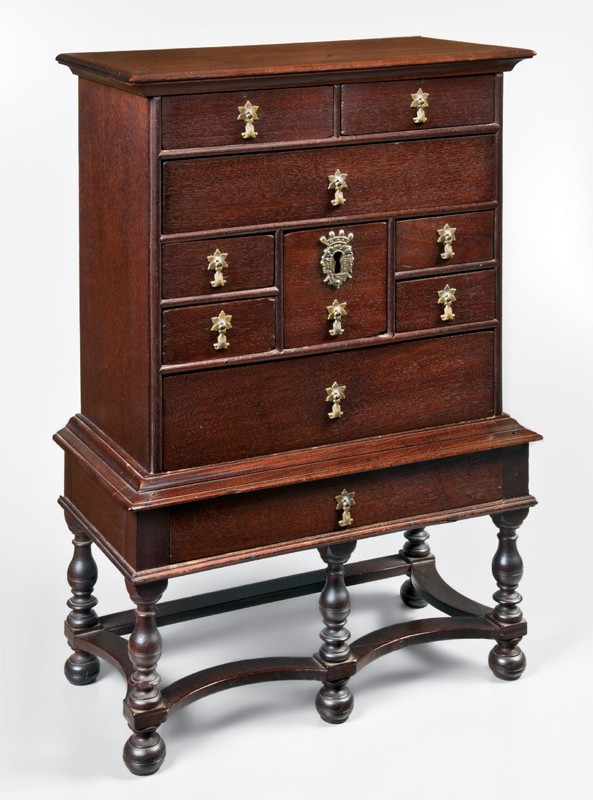
Chest-on-stand, possibly from the shop of Joseph Claypoole, Philadelphia, Pennsylvania, 1715–1725. Mahogany with white cedar, oak, and yellow pine. H. 26", W. 17", D. 9". (Private collection; photo, Gavin Ashworth.)
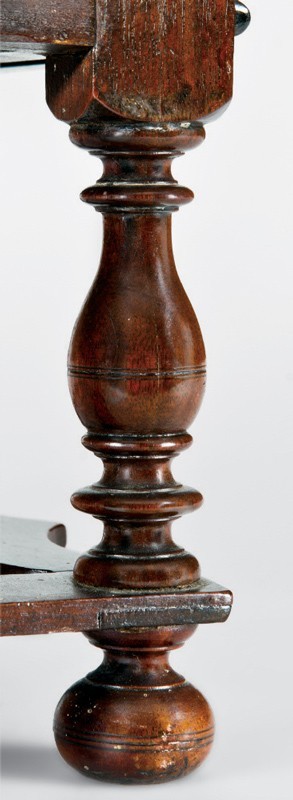
Detail of the left rear leg of the chest-on-stand illustrated in fig. 20. (Photo, Gavin Ashworth.)
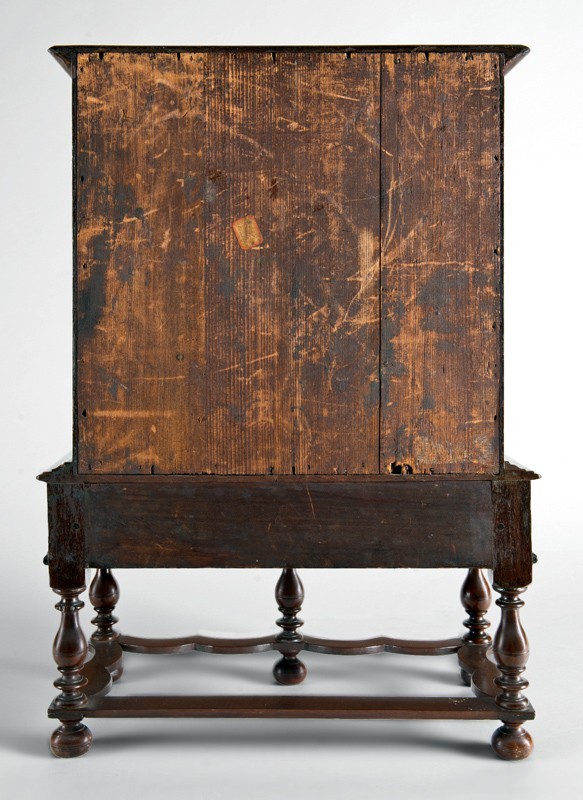
Detail of the back of the chest-on-stand illustrated in fig. 20. (Photo, Gavin Ashworth.)
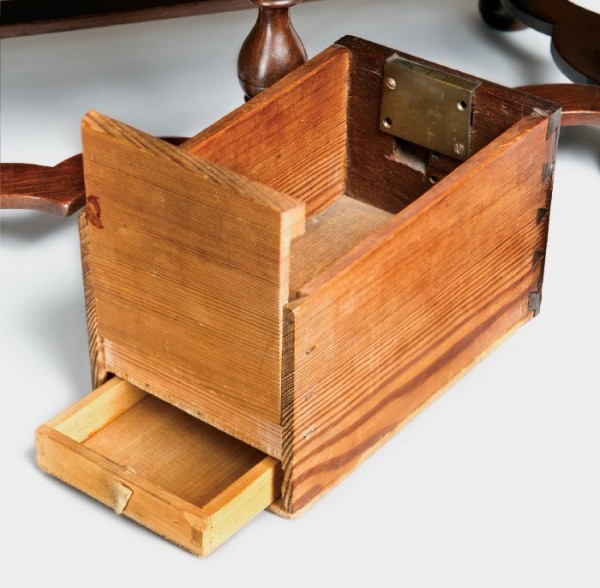
Detail of the secret compartment in the center drawer of the chest-on-stand illustrated in fig. 20. (Photo, Gavin Ashworth.)
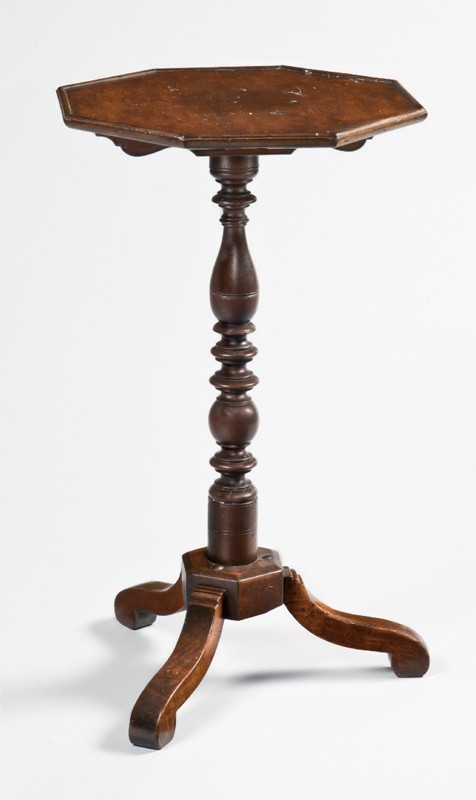
Stand, possibly from the shop of Joseph Claypoole, Philadelphia, Pennsylvania, 1715–1725. Walnut. H. 28 1/2". (Chipstone Foundation; photo, Gavin Ashworth.)
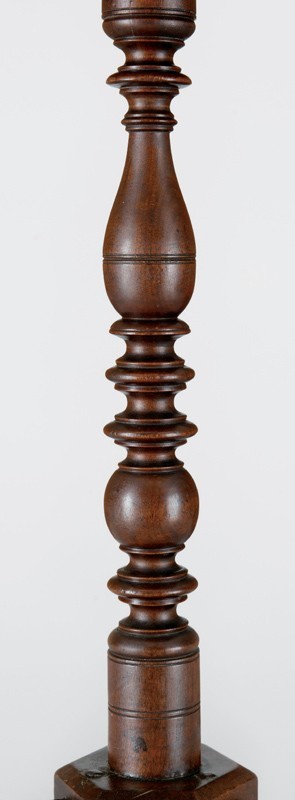
Detail of the pillar on the stand illustrated in fig. 25. (Photo, Gavin Ashworth.)
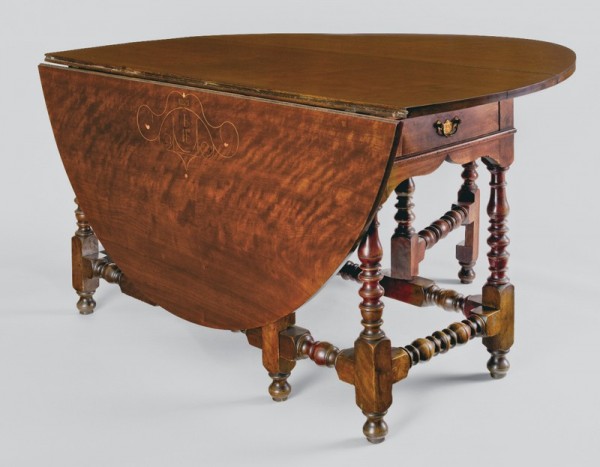
Gateleg table, possibly made by James Bartram, Chester County, Pennsylvania, 1725. Walnut and mixed wood inlays with chestnut. H. 30 3/4", top: 70" x 60" (open). (Private collection; photo, Gavin Ashworth.)
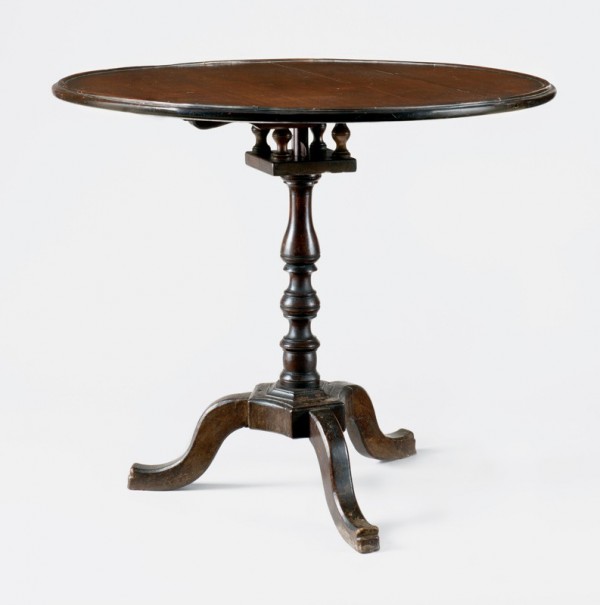
Tea table, possibly made by James Bartram, Chester County, Pennsylvania, ca. 1725. Walnut and cherry. H. 27 1/8", Diam. 31 5/8". (Private collection; photo, Gavin Ashworth.)
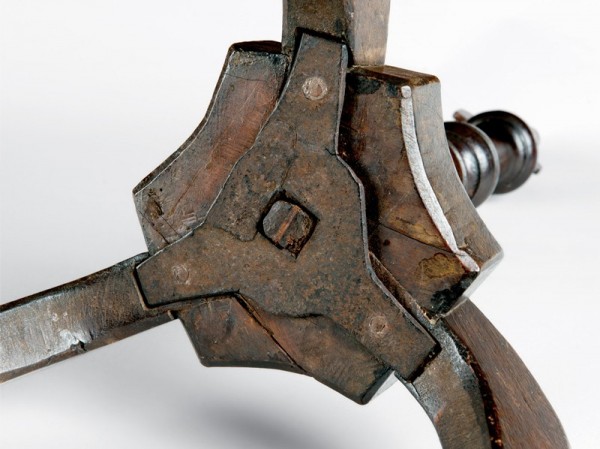
Detail of the iron plate under the hexagonal block of the tea table illustrated in fig. 28. (Photo, Gavin Ashworth.)
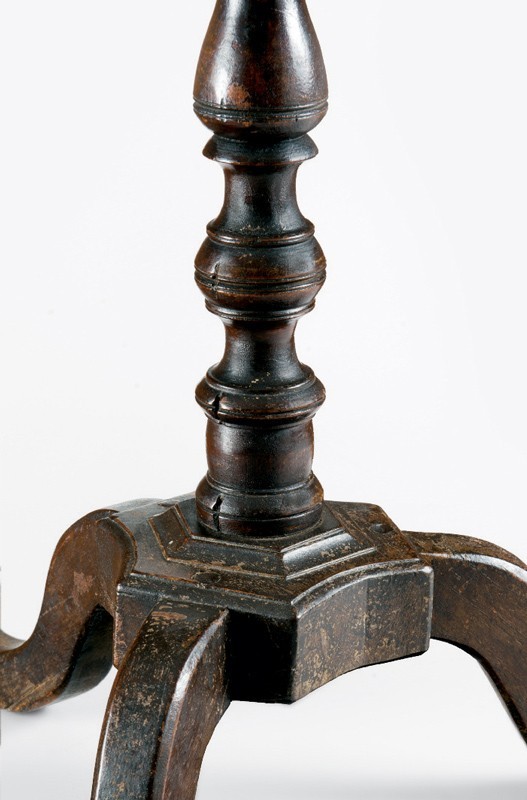
Detail of the pillar and hexagonal block of the tea table illustrated in fig. 28. (Photo, Gavin Ashworth.)

Detail of the pillar of a ca. 1770 Philadelphia candlestand. (Private collection; photo, Gavin Ashworth.)
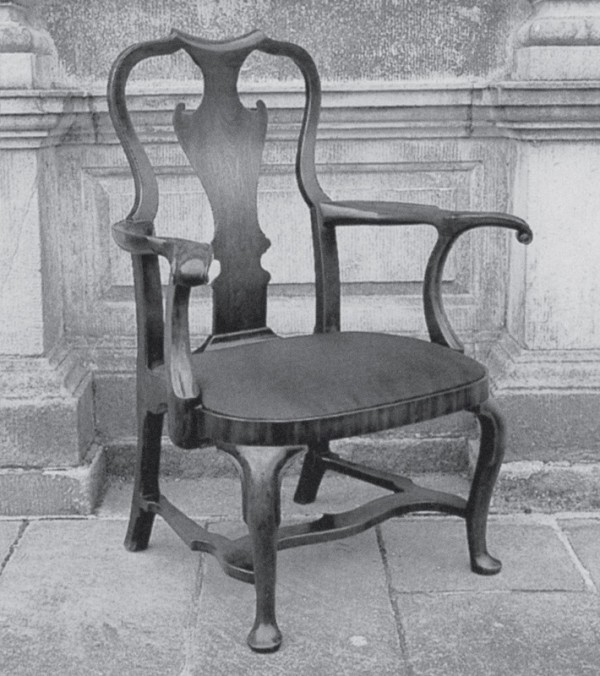
Armchair, Ireland, 1730–1745. Mahogany. Dimensions not recorded. (The Knight of Glin and James Peill, Irish Furniture: Woodwork and Carving in Ireland from the Earliest Times to the Act of Union [New Haven and London: Yale University Press, 2007], p. 205, fig. 14.)

Side chair, Ireland, 1730. Walnut. Dimensions not recorded. (The Knight of Glin and James Peill, Irish Furniture: Woodwork and Carving in Ireland from the Earliest Times to the Act of Union [New Haven and London: Yale University Press, 2007], p. 73, fig. 87.)

Side chair, Portugal or Brazil, ca. 1755. Jacardana. H. 52", W. 23", D. 21 1/2". (Courtesy, Carlton Hibbs, LLC.)

Ganging posts from a walnut board. (Photo, Michelle Williams, Jeffrey Williams Furniture Maker.) These posts are for two reproduction armchairs like those made in the shop that produced the Wistar armchair (fig. 3).

Sawing the posts of an armchair like the Wistar example (fig. 3). (Photo, Michelle Williams, Jeffrey Williams Furniture Maker.)

Laminating the posts of an armchair like the Wistar armchair (fig. 3). (Photo, Michelle Williams, Jeffrey Williams Furniture Maker.)
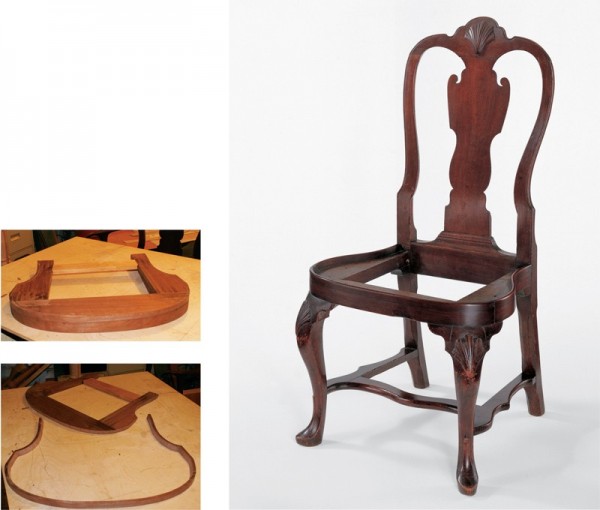
Side chair, Philadelphia, Pennsylvania, 1735–1750. Walnut with walnut and yellow pine. H. 42", W. 21 1/4", D. 20 3/4". (Chipstone Foundation; photo, Gavin Ashworth.) The procedural shots left show how the front and side seat rail moldings were cut from the front and sides of the slip seat frame.
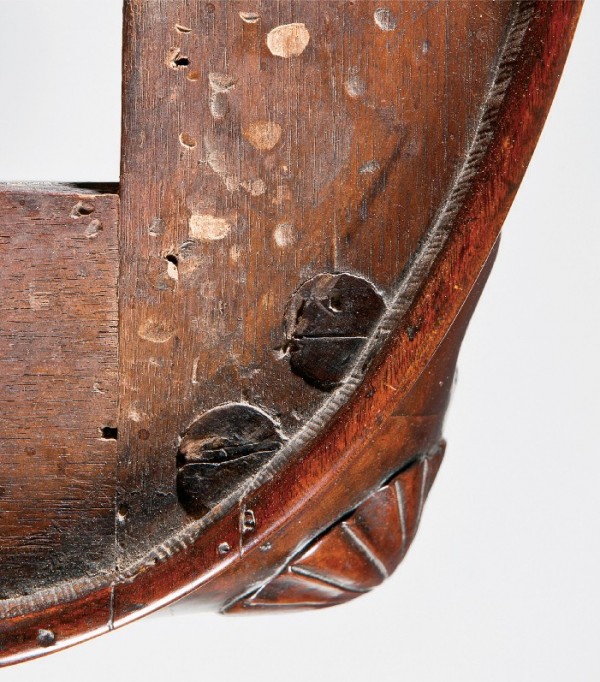
Detail of the seat rail and leg joinery of the armchair illustrated in fig. 3. (Photo, Gavin Ashworth.)

Wedged through-tenon of an armchair like the Wistar example (fig. 3). (Photo, Michelle Williams, Jeffrey Williams Furniture Maker.)

Clamping the stiles and crest of an armchair like the Wistar example (fig. 3). (Photo, Michelle Williams, Jeffrey Williams Furniture Maker.)
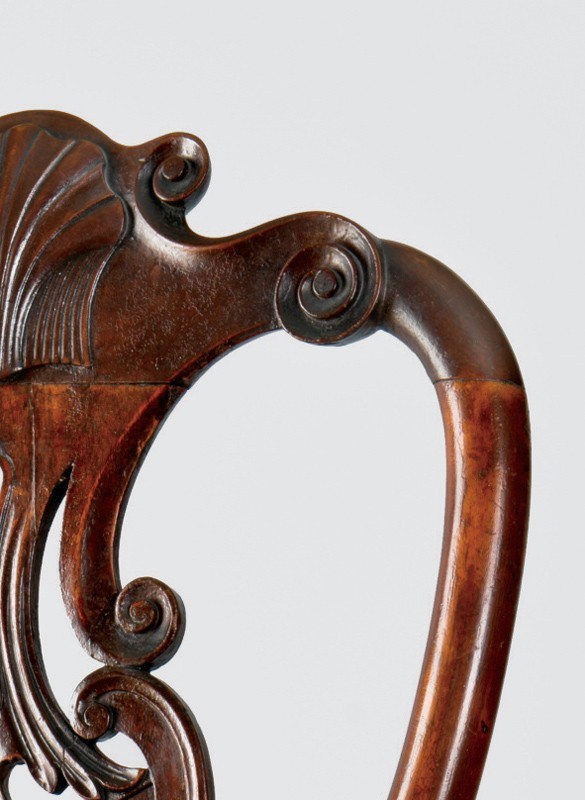
Detail showing the shaved crest and right rear stile of the side chair illustrated in fig. 61. (Photo, Gavin Ashworth.)
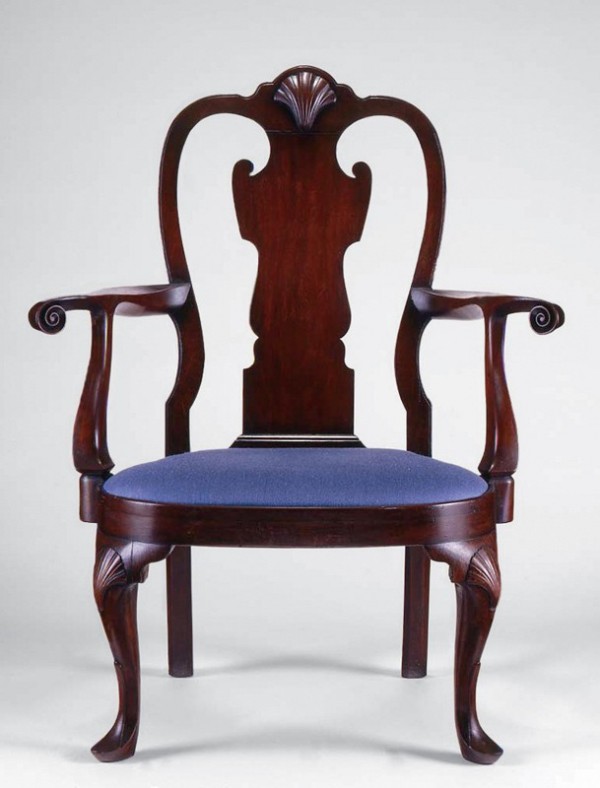
Armchair, Philadelphia, Pennsylvania, 1735–1750. Walnut with walnut and yellow pine. Dimensions not recorded. (Courtesy, Caxambas Foundation; photo, Gavin Ashworth.)
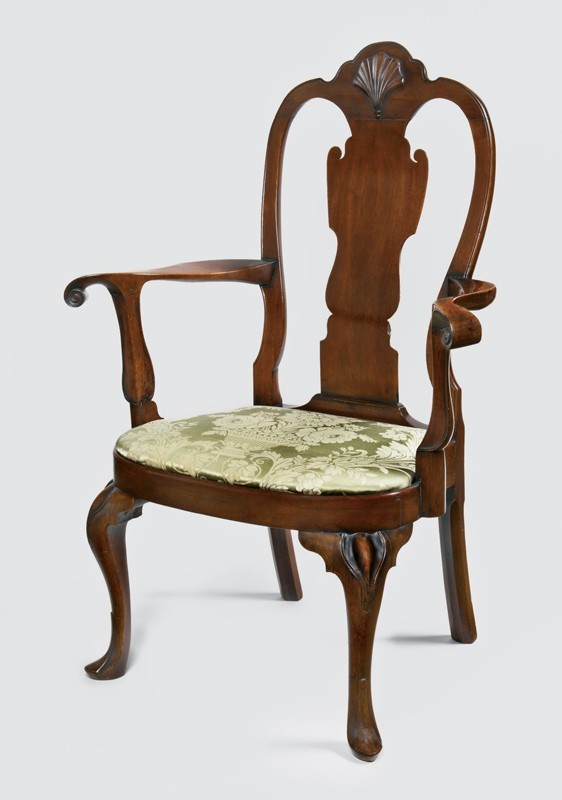
Armchair, Philadelphia, Pennsylvania, 1735–1750. Walnut with walnut and yellow pine. H. 42 3/4", W. 32 1/4", D. 24". (Courtesy, Dietrich Americana Foundation; photo, Gavin Ashworth.)
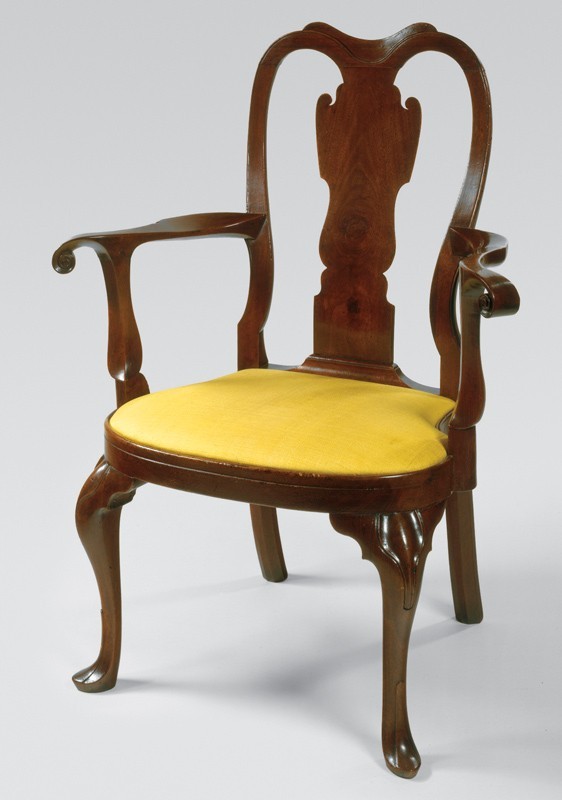
Armchair, Philadelphia, Pennsylvania, 1735–1750. Walnut with yellow pine. H. 41", W. 16 1/4" (seat), D. 18 1/2" (seat). (Courtesy, Metropolitan Museum of Art, Rogers Fund, 1925; Art Resource, NY.)
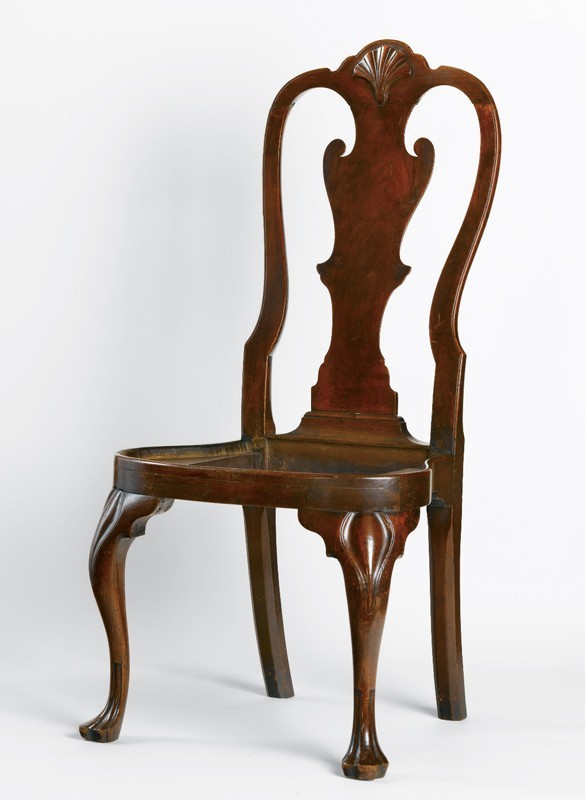
Side chair, Philadelphia, Pennsylvania, 1740–1755. Walnut with walnut and yellow pine. H. 42 1/8", W. 20 1/8", D. 18". (Private collection; photo, Gavin Ashworth.)
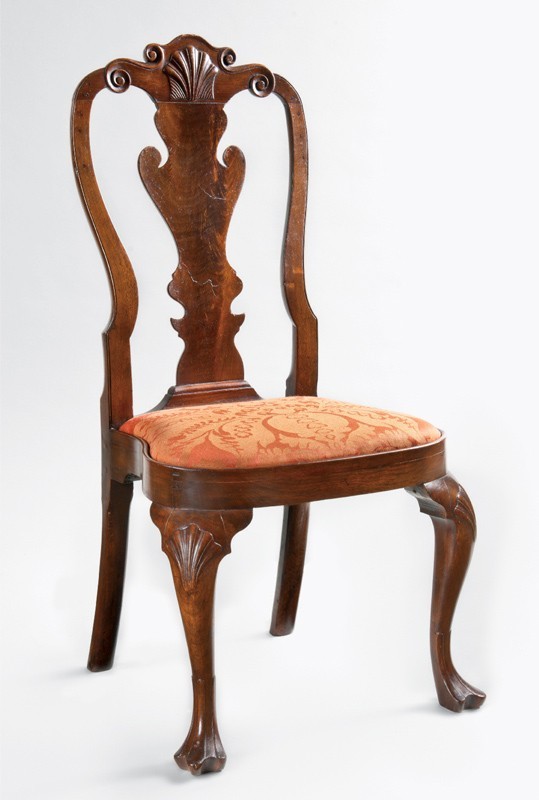
Side chair, Philadelphia, Pennsylvania, 1740–1755. Walnut. H. 41". (Private collection; photo, Gavin Ashworth.)
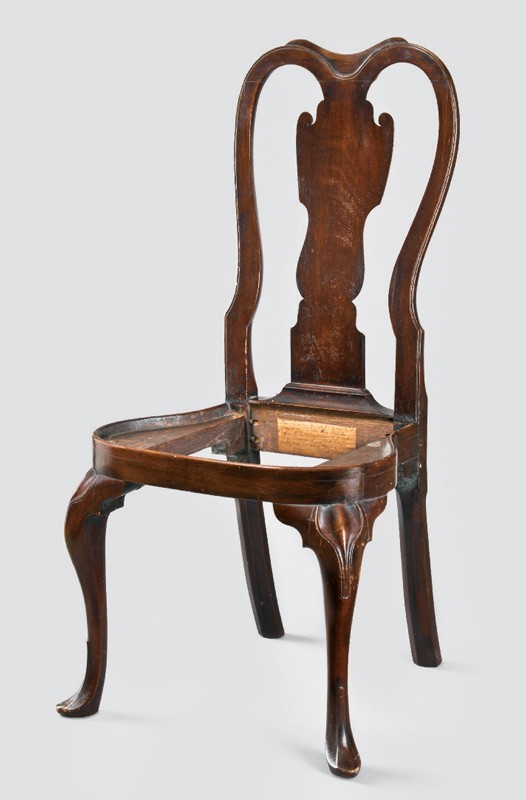
Side chair attributed to Edward Wright, Philadelphia, Pennsylvania, 1749 or 1735–1750. H. 40", W. 19 3/4", D. 20 1/2". (Courtesy, Philip Bradley Antiques; photo, Gavin Ashworth.) A label glued to the inner surface of the back rail states that the chair was “[mad]e by Edward Wright, living between Che[stnu]t and Market street in fourth Street, the _0 day of May 1749 Philadelphia, Pa.” Another label glued to the bottom of the front rail reads, “These chairs were the property of Robert Montgomery, (2nd) of Eglinton, Upper Freehold, Monmouth Co. belonged originally to th 2nd. Elisa Lawrence of Chestnut Grove Monmouth Co. New Jersey from whence they were bought [brought] Jonathan.” Although these notations are not period, they are specific enough to suggest that at least part of the information was taken from an earlier document. It is conceivable that Wright was the master of the shop that produced the Wistar armchair, but it is more likely that he worked as an apprentice there and continued to produce chairs identical to those he learned to make during his training.

Oblique and rear views of the armchair illustrated in fig. 3. (Photo, Gavin Ashworth.)
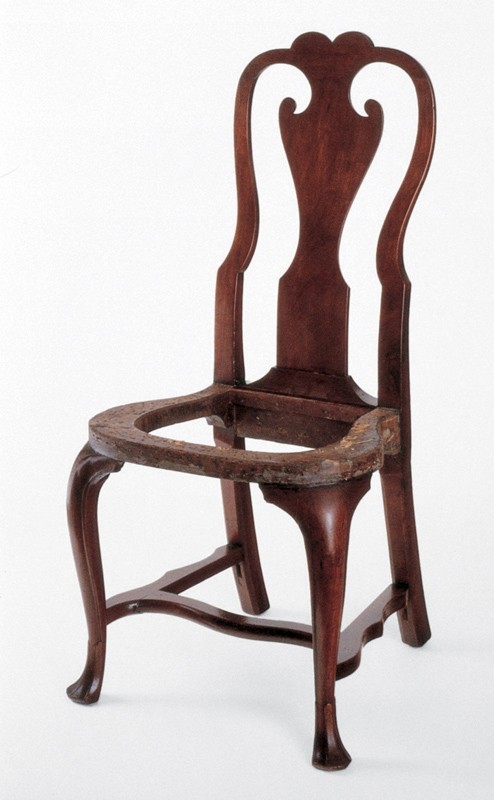
Side chair, Philadelphia, Pennsylvania, 1725–1740. Walnut. Dimensions not recorded. (Courtesy, Caxambas Foundation; photo, Gavin Ashworth.) This chair has a solid walnut splat, and none of its components is veneered.

Settee, Philadelphia, Pennsylvania, 1730–1740. Walnut. H. 45 3/4", W. 56 1/2" (seat), D. 21 1/2" (seat). (Courtesy, Metropolitan Museum of Art, Rogers Fund, 1925; Art Resource, NY.)
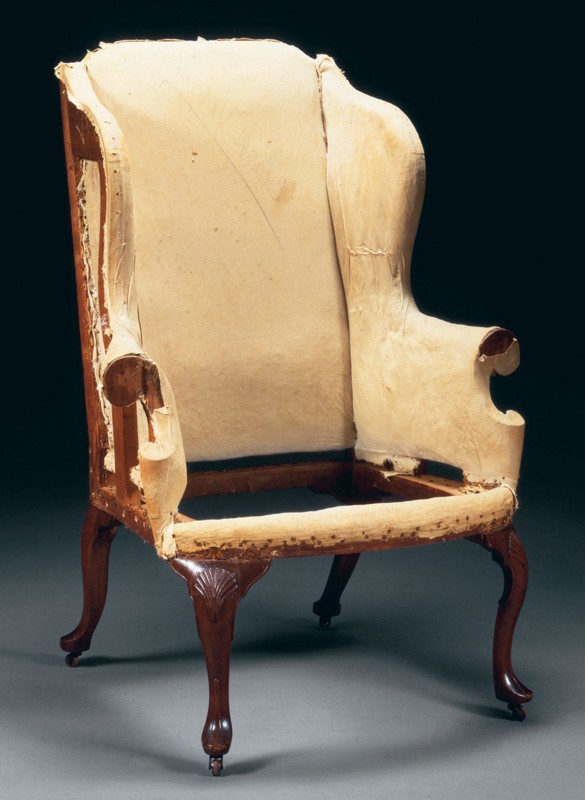
Easy chair, Philadelphia, Pennsylvania, 1730–1740. Walnut with yellow pine. H. 47 1/2", W. 33 3/4", D. 28". (Private collection; photo, Christie’s.)
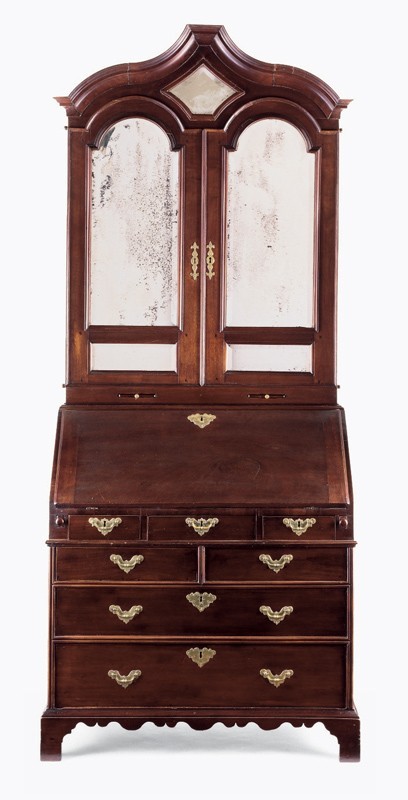
Desk-and-bookcase, possibly from the shop of Stephen Armitt, Philadelphia, Pennsylvania, 1730–1740. Mahogany and exotic hardwoods with white cedar, oak, and tulip poplar. H. 94", W. 34 3/4", D. 22". (Courtesy, National Society of the Colonial Dames of America in the Commonwealth of Pennsylvania at Stenton; photo, Gavin Ashworth.)
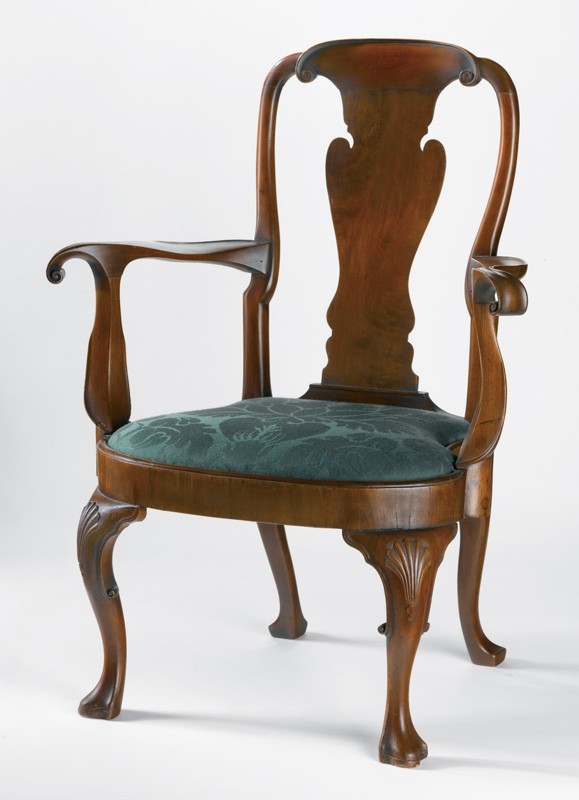
Armchair, Philadelphia, Pennsylvania, 1730–1740. Walnut and walnut veneer with yellow pine. H. 39 1/2", W. 25", D. 20". (Private collection; photo, Gavin Ashworth.)
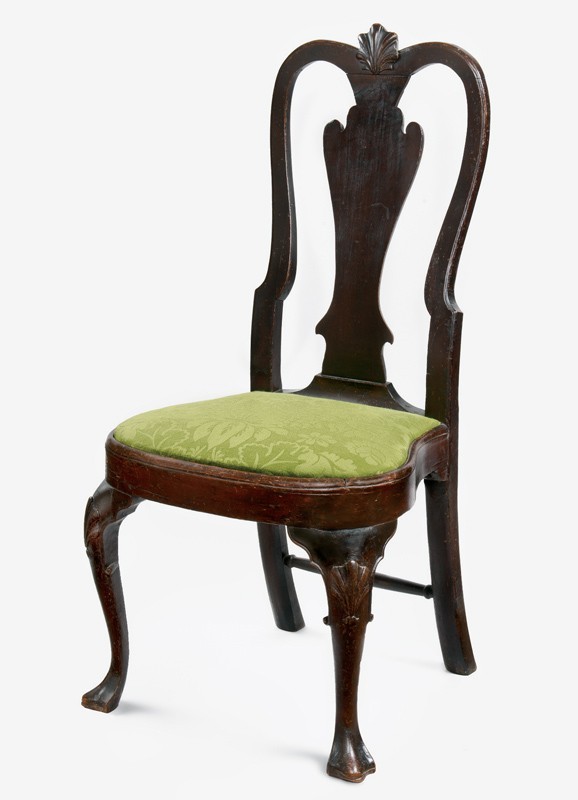
Side chair, Philadelphia, Pennsylvania, 1730–1745. Walnut and walnut veneer with walnut. H. 40", W. 20 1/2", D. 18 3/4". (Courtesy, Wright’s Ferry Mansion.)
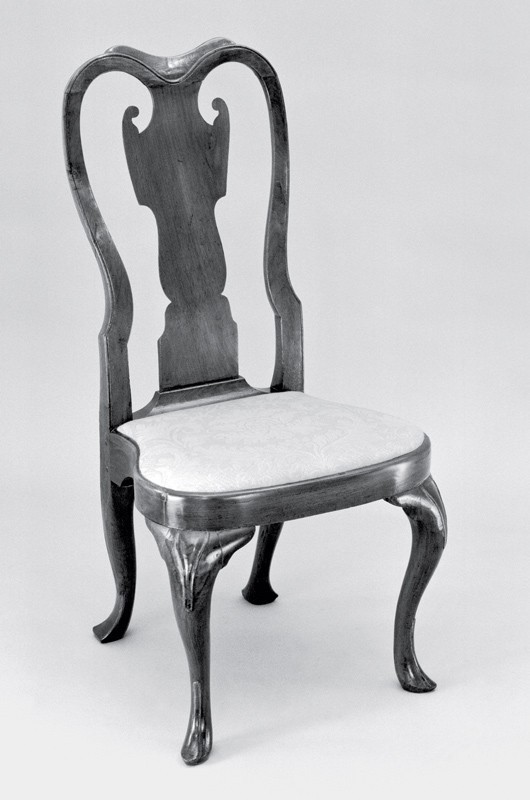
Side chair, Philadelphia, Pennsylvania, 1730–1745. Walnut and walnut veneer with unidentified secondary woods. H. 40 1/2", W. 19 7/8", D. 19 3/4". (Courtesy, Museum of Fine Arts, Houston, Bayou Bend Collection, gift of Miss Ima Hogg.)

Armchair, Philadelphia, Pennsylvania, 1735–1750. Walnut with walnut and yellow pine. H. 42 1/2", W. 24", D. 18 1/2". (Private collection; photo, Gavin Ashworth.)
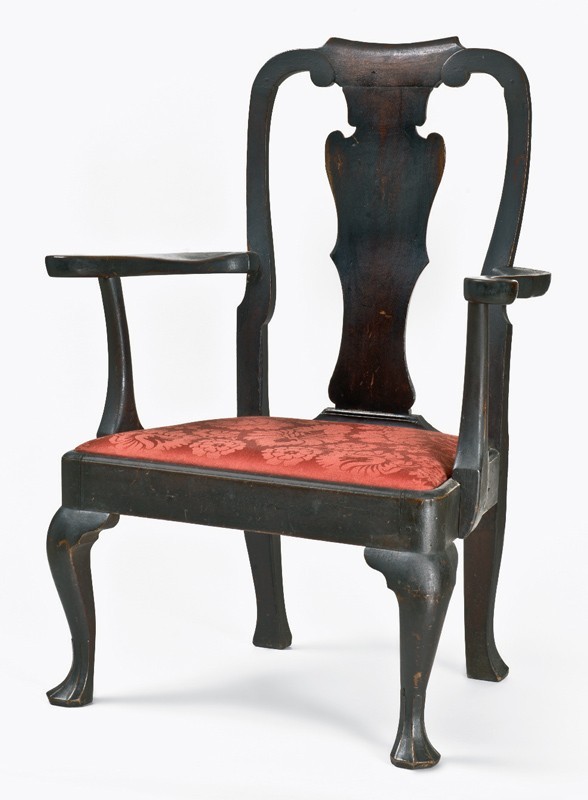
Armchair, Philadelphia, Pennsylvania, 1740–1750. Walnut with yellow pine. H. 39 1/4", W. 29 1/2" (arms), D. 19 1/2". (Private collection; photo, Gavin Ashworth.)
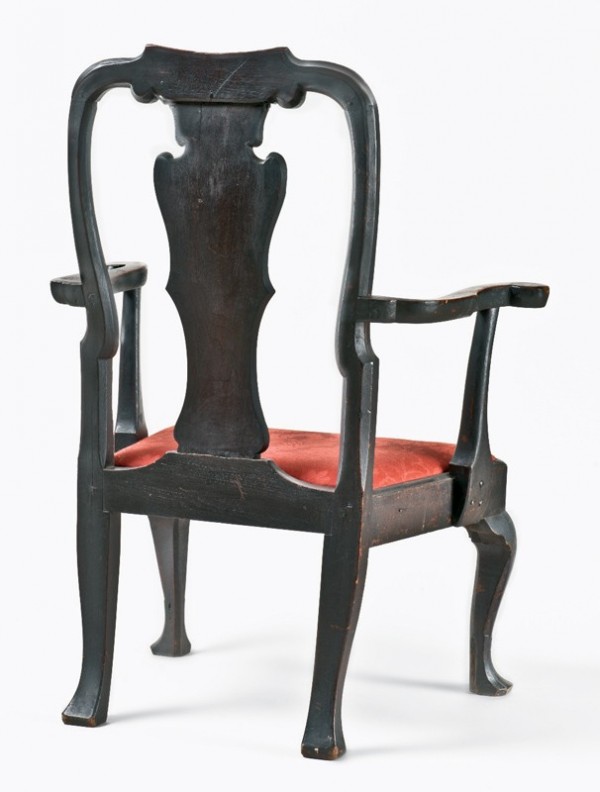
Rear view of the armchair illustrated in fig. 58. (Photo, Gavin Ashworth.) The maker of the armchair must have seen an example from the shop that produced the Logan settee and related seating forms. The very large, solid, and nonlaminated rear stiles mimic those of chairs from the Logan settee shop with considerable skill and understanding, including the inward haunch of the leg under the rear rail.
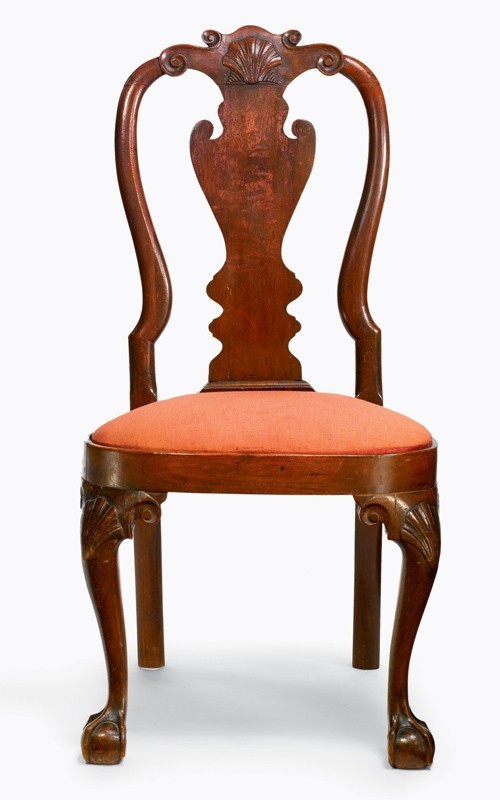
Side chair, Philadelphia, Pennsylvania, 1759. Walnut with yellow pine. H. 42 1/2", W. 20 1/8", D. 21". (Private collection; photo, Sotheby’s.)
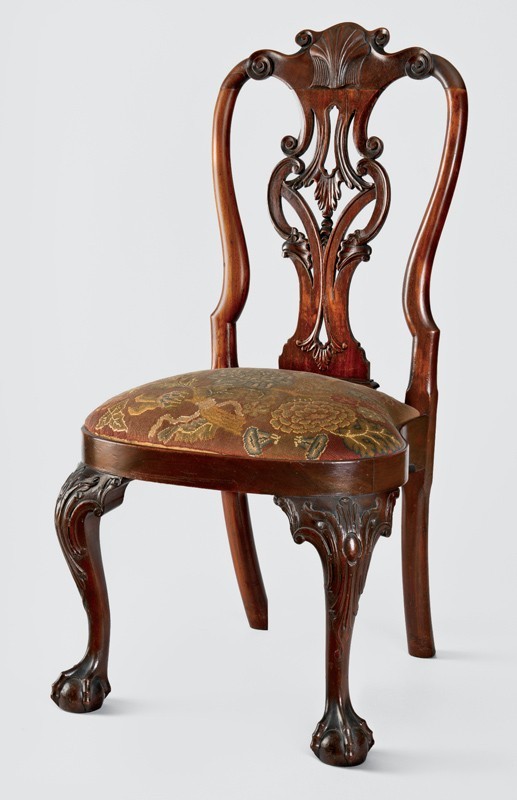
Side chair, Philadelphia, Pennsylvania, 1760–1765. Mahogany with yellow pine. H. 40 3/4", W. 20 1/8", D. 19 3/8". (Courtesy, Philadelphia Museum of Art, lent by the Commissioners of Fairmont Park; photo, Gavin Ashworth.)
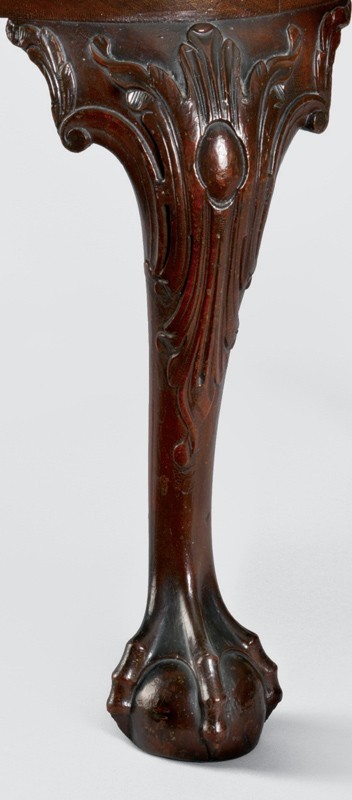
Detail of the knee carving on the side chair illustrated in fig. 61. (Photo, Gavin Ashworth.)

Dressing table attributed to the shop of John Head, Philadelphia, Pennsylvania, 1730–1740. Mahogany and maple with white cedar and yellow pine. H. 30", W. 33 1/2", D. 20". (Private collection; photo, Gavin Ashworth.) Although very much in the style of John Head, the drawer construction of the dressing table differs from his earlier, documented work. This may reflect the presence of a new craftsman in his workforce when this dressing table was made.
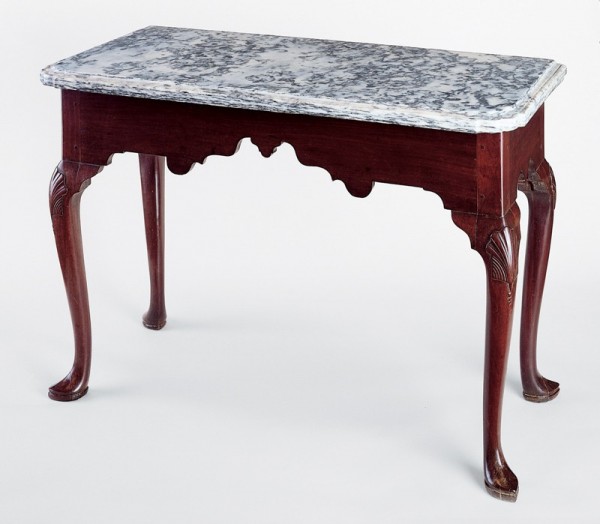
Pier table, Philadelphia, Pennsylvania, 1735–1745. Mahogany with yellow pine and white cedar; clouded limestone. H. 32 5/8", W. 42", D. 23 1/8". (Courtesy, Baltimore Museum of Art; photo, Gavin Ashworth.)
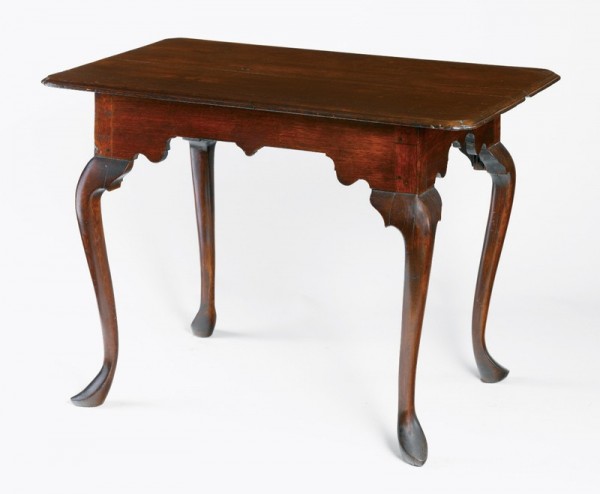
Tea table, Rappahannock River valley, Virginia, 1745–1765. Walnut. H. 29", W. 38 3/4", D. 23 5/8". (Private collection; photo, Gavin Ashworth.) This table is one of three nearly identical examples, one of which descended in the Beverly family of Essex County, Virginia.

Dressing table, Philadelphia, Pennsylvania, 1740–1750. Mahogany and mahogany veneer with yellow pine and white cedar. H. 29 1/2", W. 33", D. 20 3/4". (Private collection; photo, Philip Bradley Antiques.)
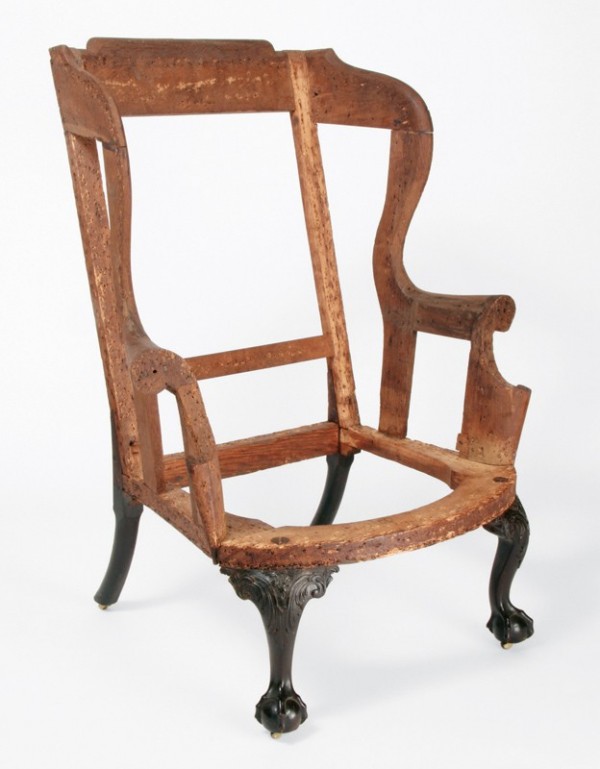
Easy chair, Philadelphia, Pennsylvania, 1765–1775. Mahogany with oak and tulip poplar. H. 46", W. 45" (arms), D. 21". (Private collection; photo, Bill Jacobs.) The non-cabriole back-sweeping rear leg remained the standard for Philadelphia chairs through the rococo era. In Britain, cabriole rear-leg use continued along with this leg design.

Thomas Hicks, Kitchen Interior, possibly Bucks County, Pennsylvania, 1865. Oil on panel. 23" x 18 1/4". (Courtesy, Dietrich American Foundation.)
